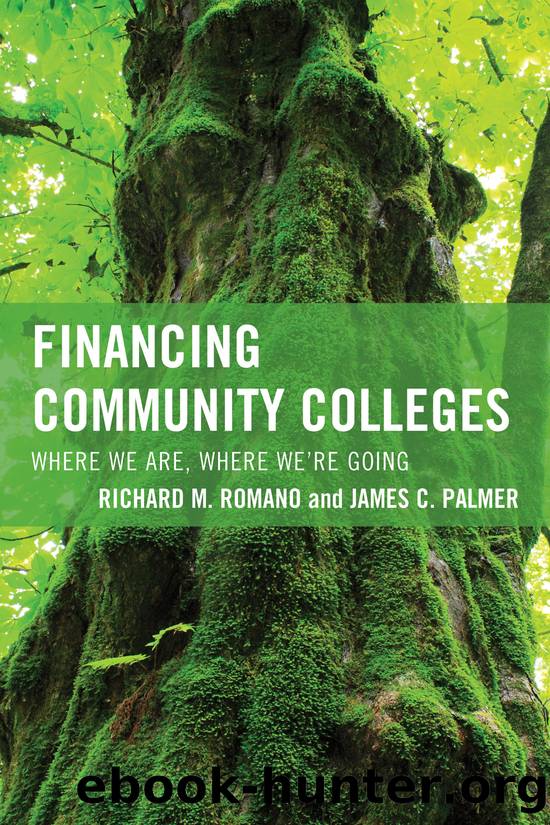Financing Community Colleges by Romano Richard M.;Palmer James C.;

Author:Romano, Richard M.;Palmer, James C.;
Language: eng
Format: epub
Publisher: Rowman & Littlefield Publishers
Note: States represented in this table are those that, according to the National Conference of State Legislatures ([NCSL] 2015), employed PBF mechanisms to allocate at least some portion of state monies on the basis of student outcomes to community colleges. North Dakota, though listed by the NCSL as having a PBF system, is not included, because its PBF system is based on credit hour completion (NCSL, 2015). The table details only student outcomes indicators employed in PBF programs, not curricular or other measures that might be employed (e.g., monies tied to increases in the use of distance learning technology, in the development of articulation agreements, etc.).
Sources: Arkansas Department of Higher Education (2014), Illinois Community College Board (n.d.), Indiana Commission for Higher Education (n.d., 2013), Kansas Board of Regents (2014), Louisiana Board of Regents (2014), Missouri Department of Higher Education (2014), Montana University System (n.d.), NCSL (2015), Nelson and Keller (2014), Nevada System of Higher Education (n.d.), New Mexico Department of Higher Education (2013, 2014), North Carolina State Board of Community Colleges (2013), Ohio Board of Regents (2014), Oklahoma State Regents for Higher Education (n.d.), Omnibus Higher Education Appropriations Bill (2013), Performance Indicators Task Force (n.d.), Tennessee Higher Education Commission (n.d.), Texas Legislature (2013), University of Hawaiâi System (2014), Utah State Legislature (2013), Virginia Higher Education Opportunity Act of 2011, Washington State Board for Community and Technical Colleges (2012), Wisconsin Technical College System (2015).
aProposed metrics for 2013â15. In addition to a measure of on-time graduation, each institution will employ one additional âproductivity metric linked to their strategic planâ (Indiana Commission for Higher Education, n.d., p. 13). bKansas colleges and universities enter into performance agreements with the Kansas Board of Regents (KBR). New monies are âcontingent upon achieving complianceâ with those agreements (KBR, 2014, p. 3). Measures listed here include those that institutions can select from in meeting two goals in the KBR strategic plan: âincreasing higher education attainmentâ and âmeeting the needs of the Kansas economyâ (KBR, 2014, p. 6). Community and technical colleges must also include three additional institution-specific indicators related to the KBRâs strategic plan, âone of which measures a non-college ready student populationâ (KBR, 2014, p. 6). cInstitutions enter into six-year performance agreements committing them to meet âspecific performance objectives in exchange for increased tuition authority and eligibility to participate in certain autonomiesâ (Louisiana Board of Regents, n.d., para. 1). Performance objectives include curricular and efficiency measures (e.g., elimination of programs not aligned with state needs or that have low completion rates) in addition to the outcomes indicators listed here. dProposed performance metrics for fiscal years 2016 and 2017. eProposed metrics. fIn addition to mission-specific measures. gTechnical College System only.
Notably absent from the list in Table 5.1 is any reference to specific learning outcomes. Nor as Jones (2013) has indicated, has any âstate explicitly included a quality metric in its funding modelâ (p. 6). This seems appropriate, given the inability of colleges and universities to this point to come up with an acceptable way of measuring these two interrelated outcomes.
Download
This site does not store any files on its server. We only index and link to content provided by other sites. Please contact the content providers to delete copyright contents if any and email us, we'll remove relevant links or contents immediately.
Chicken Soup for the Soul Presents Teens Talkin' Faith by Jack Canfield(806)
Understanding PDA Autism in Kids: A Guide for Parents and Teachers to Support Neurodiverse Learners by Jehu Len(567)
The Victorian Era: A Captivating Guide to the Life of Queen Victoria and an Era in the History of the United Kingdom Known for Its Hierarchy-Based Social Order by Captivating History(441)
Brain Teasers to Build Critical Thinking Skills: Brain Exercises for Tech, Banking, Case Interview Prep, and to Keep Your Mind Sharp by Kris Safarova(421)
Brain Teasers to Build Critical Thinking Skills by Safarova Kris(420)
100 Ideas for Secondary Teachers: Engaging Parents by Janet Goodall & Kathryn Weston(393)
Python 101 - Fundamentals by Sam(379)
Critical Curriculum Leadership : A Framework for Progressive Education by Rose M. Ylimaki(371)
Writing Solid Code: Development Philosophies for Writing Bug-Free Programs by Steve Maguire(364)
Intersectionality in Educational Research by Dannielle Joy Davis; James L. Olive; Rachelle J. Brunn-Bevel; Susan R. Jones(341)
The Art of Emotional Validation: Improve Your Communication Skills and Transform Your Relationships by Validating Emotions and Feelings by Emily Wright(341)
The Knights Templar: An Enthralling History of the Rise and Fall of the Most Influential Catholic Military Order by Wellman Billy(336)
A Beginner's Guide to SSD Firmware by Unknown(332)
The Future Knowledge Compendium by Ellyard Peter;(324)
How to be assertive in any situation by Hadfield Sue & Hasson Gill(317)
What Every Teacher Should Know about Learning, Memory, and the Brain by Tileston Donna E. Walker;(312)
Making Connections in and Through Arts-Based Educational Research by Hala Mreiwed Mindy R. Carter Sara Hashem Candace H. Blake-Amarante(310)
Foundations of Educational Research by Victoria Elliott(309)
Message from the Pleiades; The Contact Notes of Eduard Billy Meier v1 only by unknow(307)
